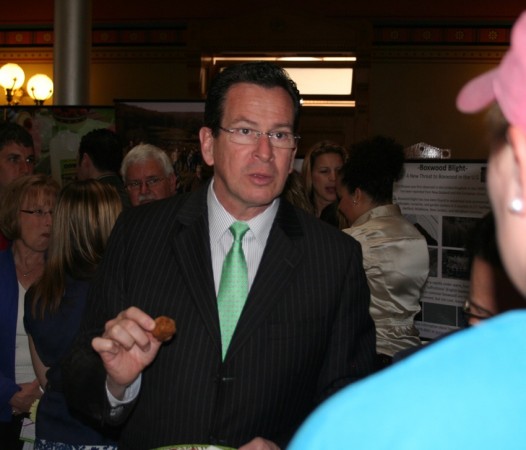Ag Day At The Capitol – From Coast to Coast
 On one side of the continent Ag Day at the Capitol brought out a crowd to try fresh briny oysters, crunchy apples, sweet honey, cups of fresh milk, maple syrup – along with scientists and folks representing some 50 different agricultural interests in Connecticut. On the opposite side of the U.S.A., horses crunched local-grown carrots at California's Ag Day, which also featured walnuts, rice and rodeo queens and growing concerns about adequate water supplies for crops. (Sacramento Press report linked here.) Both states held the annual event on the same day this year; Colorado, Wisconsin and Tennessee and others celebrate ag farmers and producers on days of their choice.
On one side of the continent Ag Day at the Capitol brought out a crowd to try fresh briny oysters, crunchy apples, sweet honey, cups of fresh milk, maple syrup – along with scientists and folks representing some 50 different agricultural interests in Connecticut. On the opposite side of the U.S.A., horses crunched local-grown carrots at California's Ag Day, which also featured walnuts, rice and rodeo queens and growing concerns about adequate water supplies for crops. (Sacramento Press report linked here.) Both states held the annual event on the same day this year; Colorado, Wisconsin and Tennessee and others celebrate ag farmers and producers on days of their choice.
“Eating is an agricultural act.” – Wendell Berry
 Fresh oysters harvested from the waters of Connecticut were shucked and shared, part of the Connecticut Seafood Council booth. A handy chart was available for what products are freshest and best in each month – listings ranged from clams, scallops, shad, squid, whelk, lobsters, flounder, sea bass, blackfish, bluefish and other species.
Fresh oysters harvested from the waters of Connecticut were shucked and shared, part of the Connecticut Seafood Council booth. A handy chart was available for what products are freshest and best in each month – listings ranged from clams, scallops, shad, squid, whelk, lobsters, flounder, sea bass, blackfish, bluefish and other species.
Dr. Louis Magnarelli, director of the Connecticut Agricultural Experiment Station, and Dr. Sharon Douglas, head of the Department of Plant Pathology & Ecology and plant pathologist there, shared information about boxwood blight and news that scientists have recently identified Pachysandra terminalis as a host of the fungus that causes the blight. The Ag Station is where science meets the human community and environment and where farm produce is inspected and certified for export out of the state. Scientists test for West Nile Virus and other mosquito-carried diseases along with tick-borne diseases, and that's just a part of the station's ongoing mission to maintain the well-being of humans in the state and across the nation.
 Speaking for the bees, Ted Jones of Jones Apiary spread the word about how to encourage these busy pollinators with bee-friendly plantings. A brochure illuminated just how important honeybees are in the production of tree fruit, berries, and garden crops. (Not to mention their delicious local honey, which many people swear helps defuse allergies.) Ted is a beekeeper and serves as president of the Connecticut Beekeepers Association, as well as past vice president/program chair and past director for the Eastern Apiculture Society.
Speaking for the bees, Ted Jones of Jones Apiary spread the word about how to encourage these busy pollinators with bee-friendly plantings. A brochure illuminated just how important honeybees are in the production of tree fruit, berries, and garden crops. (Not to mention their delicious local honey, which many people swear helps defuse allergies.) Ted is a beekeeper and serves as president of the Connecticut Beekeepers Association, as well as past vice president/program chair and past director for the Eastern Apiculture Society.
 More than 50 agricultural associations from apple growers to the Farm Bureau had booths, displays and take-home information to connect with legislative leaders and policy makers about what they do and how laws and policies will affect them. Visitors and legislators sampled the wares and chatted with the crowd. Steven Revicky, commissioner, Department of Agriculture, read the official proclamation for the event.
More than 50 agricultural associations from apple growers to the Farm Bureau had booths, displays and take-home information to connect with legislative leaders and policy makers about what they do and how laws and policies will affect them. Visitors and legislators sampled the wares and chatted with the crowd. Steven Revicky, commissioner, Department of Agriculture, read the official proclamation for the event.
Governor Dannel Malloy then presented the 2012 Young Farmer of the Year award to Russell Holmberg of Holmberg Orchard & Farm Winery, a fourth-generation family farm located Gales Ferry.
Seen and heard: The Connecticut Dairy Industry Council refreshed the crowds with taster cups of fresh milk. Opportunities for “new energy for your ag business” drew interest at Farm Credit East.
 The Connecticut State Grange leaflet tells the story of this farm community organization with roots back to 1867 and lists the nearly 60 Granges in the state. Also helpful is the 2012 guide to agricultural fairs with how to enter a quilt or baking contest along with the dates for horse, tractor, oxen pulls, lawnmower races and horse shows.
The Connecticut State Grange leaflet tells the story of this farm community organization with roots back to 1867 and lists the nearly 60 Granges in the state. Also helpful is the 2012 guide to agricultural fairs with how to enter a quilt or baking contest along with the dates for horse, tractor, oxen pulls, lawnmower races and horse shows.

Back to California, where Department of Food and Agriculture Secretary Karen Ross encouraged companies to participate in agricultural export development and training programs.
“California has a significant role in the world economy – providing a wide variety of food and agricultural products to foreign markets which helps to meet global food demands,” said Secretary Ross. “I encourage companies to access these important programs to assist in developing export markets for their products.” Leading export products included almonds, rice, wine, pistachios and walnuts.
On average, California farmers and ranchers export 22 percent of the products they produce.
The top destinations for the state's agricultural products? Canada, Europe, Japan, China/Hong Kong and Mexico.
